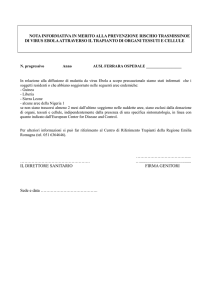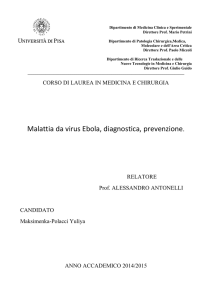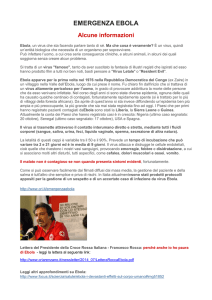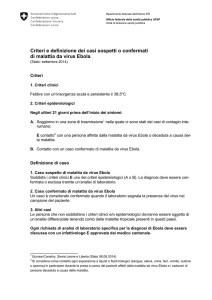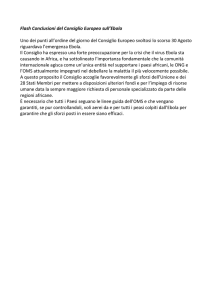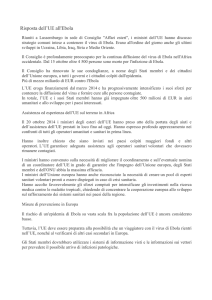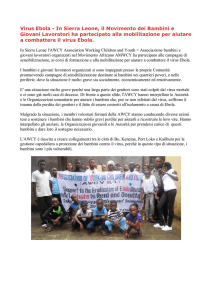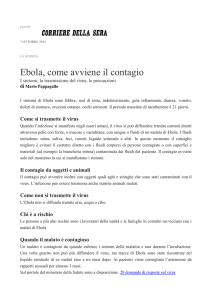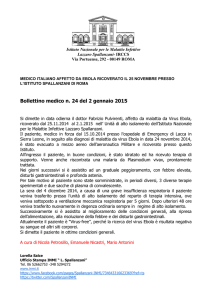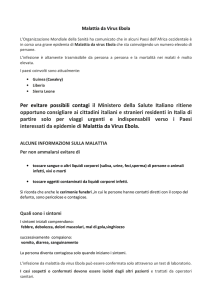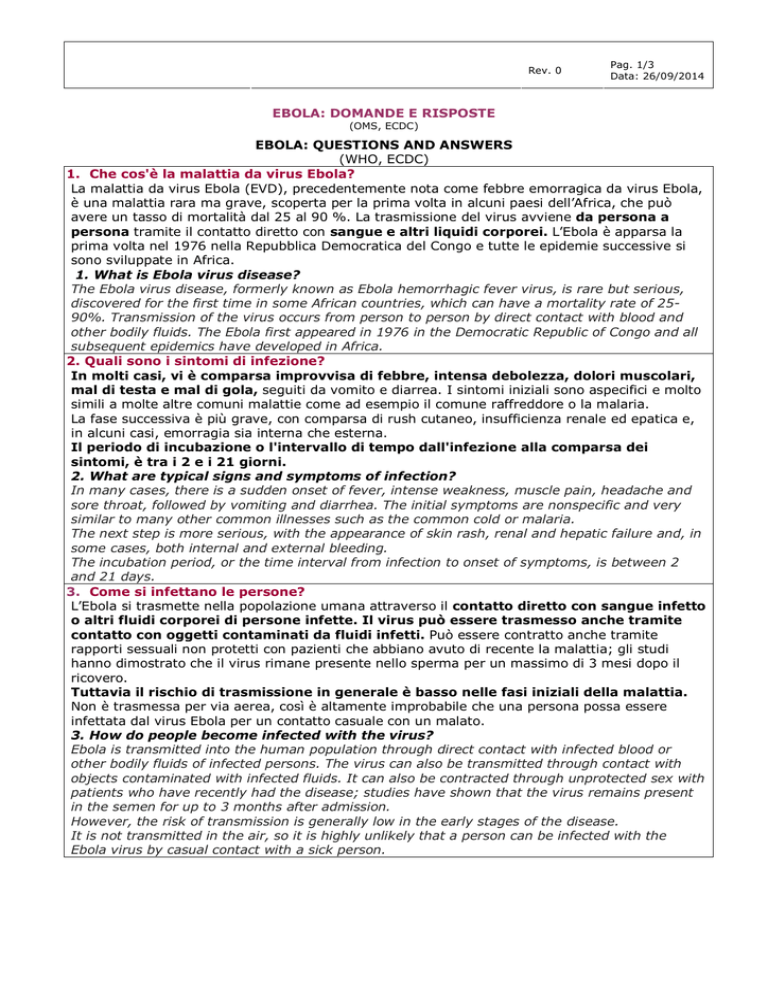
Rev. 0
Pag. 1/3
Data: 26/09/2014
EBOLA: DOMANDE E RISPOSTE
(OMS, ECDC)
EBOLA: QUESTIONS AND ANSWERS
(WHO, ECDC)
1. Che cos'è la malattia da virus Ebola?
La malattia da virus Ebola (EVD), precedentemente nota come febbre emorragica da virus Ebola,
è una malattia rara ma grave, scoperta per la prima volta in alcuni paesi dell’Africa, che può
avere un tasso di mortalità dal 25 al 90 %. La trasmissione del virus avviene da persona a
persona tramite il contatto diretto con sangue e altri liquidi corporei. L’Ebola è apparsa la
prima volta nel 1976 nella Repubblica Democratica del Congo e tutte le epidemie successive si
sono sviluppate in Africa.
1. What is Ebola virus disease?
The Ebola virus disease, formerly known as Ebola hemorrhagic fever virus, is rare but serious,
discovered for the first time in some African countries, which can have a mortality rate of 2590%. Transmission of the virus occurs from person to person by direct contact with blood and
other bodily fluids. The Ebola first appeared in 1976 in the Democratic Republic of Congo and all
subsequent epidemics have developed in Africa.
2. Quali sono i sintomi di infezione?
In molti casi, vi è comparsa improvvisa di febbre, intensa debolezza, dolori muscolari,
mal di testa e mal di gola, seguiti da vomito e diarrea. I sintomi iniziali sono aspecifici e molto
simili a molte altre comuni malattie come ad esempio il comune raffreddore o la malaria.
La fase successiva è più grave, con comparsa di rush cutaneo, insufficienza renale ed epatica e,
in alcuni casi, emorragia sia interna che esterna.
Il periodo di incubazione o l'intervallo di tempo dall'infezione alla comparsa dei
sintomi, è tra i 2 e i 21 giorni.
2. What are typical signs and symptoms of infection?
In many cases, there is a sudden onset of fever, intense weakness, muscle pain, headache and
sore throat, followed by vomiting and diarrhea. The initial symptoms are nonspecific and very
similar to many other common illnesses such as the common cold or malaria.
The next step is more serious, with the appearance of skin rash, renal and hepatic failure and, in
some cases, both internal and external bleeding.
The incubation period, or the time interval from infection to onset of symptoms, is between 2
and 21 days.
3. Come si infettano le persone?
L’Ebola si trasmette nella popolazione umana attraverso il contatto diretto con sangue infetto
o altri fluidi corporei di persone infette. Il virus può essere trasmesso anche tramite
contatto con oggetti contaminati da fluidi infetti. Può essere contratto anche tramite
rapporti sessuali non protetti con pazienti che abbiano avuto di recente la malattia; gli studi
hanno dimostrato che il virus rimane presente nello sperma per un massimo di 3 mesi dopo il
ricovero.
Tuttavia il rischio di trasmissione in generale è basso nelle fasi iniziali della malattia.
Non è trasmessa per via aerea, così è altamente improbabile che una persona possa essere
infettata dal virus Ebola per un contatto casuale con un malato.
3. How do people become infected with the virus?
Ebola is transmitted into the human population through direct contact with infected blood or
other bodily fluids of infected persons. The virus can also be transmitted through contact with
objects contaminated with infected fluids. It can also be contracted through unprotected sex with
patients who have recently had the disease; studies have shown that the virus remains present
in the semen for up to 3 months after admission.
However, the risk of transmission is generally low in the early stages of the disease.
It is not transmitted in the air, so it is highly unlikely that a person can be infected with the
Ebola virus by casual contact with a sick person.
Rev. 0
Pag. 2/3
Data: 26/09/2014
4. Quanto è contagiosa la malattia?
Le persone diventano contagiose alla comparsa dei sintomi. Il rischio di infettarsi nelle prime fasi
della malattie è generalmente basso. Il rischio di infezione è più alto nelle fasi avanzate della
malattia ma può essere significativamente ridotto con l’uso di appropriati dispositivi di protezione
individuale.
4. How contagious is it?
People become contagious to the onset of symptoms. The risk of becoming infected in the early
stages of the disease is generally low. The risk of infection is higher in the advanced stages of the
disease but can be significantly reduced using appropriate personal protective equipment.
5. Qual è la mortalità?
La mortalità nei pazienti che hanno sviluppato la malattia varia dal 25 al 90%, a seconda del tipo
di virus contratto.
5. How dedly is it?
The mortality in patients who have developed the disease is 25-90%, depending on the virus
type.
6. Quanto è resistente il virus EBOLA?
Il virus Ebola viene ucciso facilmente da sapone, candeggina, luce solare o asciugatura.
Il lavaggio in lavatrice di indumenti contaminati da liquidi è sufficiente a distruggere il virus Ebola.
6. Is the virus resistant?
The Ebola virus is easily killed by soap, bleach, sunlight or drying.
Machine wash clothing contaminated with liquid is sufficient to destroy the Ebola virus.
7. E’ disponibile un vaccino?
Non ci sono vaccini approvati al momento ma la ricerca è in corso.
7. Is there a vaccine?
There is no approvated vaccine at this point but research in ongoing.
8. Qual è il trattamento?
Attualmente non esiste un trattamento specifico per curare la malattia. I pazienti gravemente
malati necessitano di terapia intensiva, sono spesso disidratati e hanno bisogno di liquidi per via
endovenosa o di reidratazione orale con soluzioni contenenti elettroliti.
Alcuni pazienti con terapie mediche appropriate guariscono.
8. What is the treatment?
Currently there is no specific treatment to cure the disease. The severely ill patients requiring
intensive care, are often dehydrated and need intravenous fluids or oral rehydration with
solutions containing electrolytes.
Some patients recover with appropriate medical treatment.
9. C’è rischio che i viaggiatori provenienti da paesi ove vi è l’epidemia diffondano il
virus Ebola in Europa o in Italia?
Le persone affette dalla malattia possono arrivare in Europa senza avere il sospetto di aver
contratto il virus. Possono mostrare i sintomi durante il viaggio, una volta ritornati a casa o alcuni
giorni più tardi.
Le Autorità di Sanità Pubblica in Europa e in Italia possono tempestivamente porre la diagnosi di
sospetto e quindi confermare i casi di ebola e così prevenirne la diffusione.
Il rischio secondario di trasmissione per contatto diretto o in ospedale è molto basso, se vengono
applicate le misure di prevenzione previste.
9. Is there a risk that travellers from affected countries bring Ebola in Europe or in
Italy?
People with the disease can get to Europe without having the suspicion of having contracted the
virus. They may show symptoms during the trip, once back home, or a few days later.
In Europe and in Italy, Public Health Authorities can promptly make the diagnosis of suspected
and then confirmed cases of Ebola and so prevent its spread.
The risk of secondary transmission by direct contact or in hospital is very low when applied the
precautionary measures provided.
Rev. 0
Pag. 3/3
Data: 26/09/2014
10. Quando si dovrebbe cercare assistenza sanitaria?
Se una persona sviluppa febbre, intensa debolezza, dolori muscolari, mal di testa, mal di
gola ed ha soggiornato in uno dei Paesi dell’Africa ove è presente l’epidemia da virus
Ebola o ha avuto contatto con sangue, secrezioni o altri fluidi corporei di una persona infetta,
dovrebbe immediatamente recarsi dal medico, ricordando che è fondamentale che segnali la sua
storia del viaggio.
Cure mediche immediate sono essenziali per aumentare il tasso di sopravvivenza dalla malattia.
Le cure mediche sono importanti anche per controllare la diffusione della malattia ed avviare
immediatamente le procedure di controllo dell'infezione.
10. When to seek medical attention?
If a person develops fever, intense weakness, muscle pain, headache, sore throat and
stayed in one of the African countries where the epidemic is by Ebola virus or has had
contact with blood, secretions or other bodily fluids of an infected person, you should
immediately go to the doctor, pointing out that it is essential that mentions your travel history.
Immediate medical care are essential to increase the survival rate from the disease. Medical
care is also important to control the spread of the disease and immediately start the infection
control procedures.
11. Quali sono i Paesi dell’Africa occidentale affetti dall’epidemia di Malattia da virus
Ebola?
Le comunicazioni fornite dall’Organizzazione Mondiale della Sanità informano che i Paesi
dell’Africa occidentale affetti dall’epidemia di Malattia da virus Ebola sono, al momento:
• Guinea (Conakry)
• Liberia
• Sierra Leone
• Nigeria
Al 20 agosto, sono stati segnalati dai quattro paesi, il totale di casi attribuibili a MVE nei quattro
paesi si attesta a 2615 di cui 1427 decessi.
Dal 26 agosto, è notificato anche un nuovo focolaio probabilmente non correlato con l'epidemia
negli altri quattro paesi africani, con 20 casi sospetti di cui 13 decessi:
• Repubblica democratica del Congo
11. What are the West African countries affected by the epidemic of Ebola virus
disease?
The communications provided by the World Health Organization advised that West African
countries affected by the epidemic of Ebola virus disease are, at the moment:
• Guinea (Conakry)
• Liberia
• Sierra Leone
• Nigeria
20 August, were reported by four countries, the total number of cases attributable to MVE in the
four countries stood at 2615 of which 1427 deaths.
From August 26, is also notified a new outbreak probably not related to the outbreak in the four
other African countries, with 20 suspected cases including 13 deaths:
• Democratic Republic of Congo

